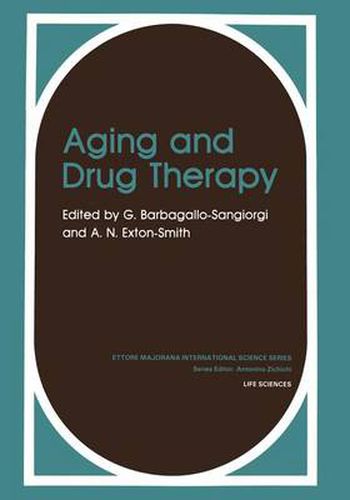Readings Newsletter
Become a Readings Member to make your shopping experience even easier.
Sign in or sign up for free!
You’re not far away from qualifying for FREE standard shipping within Australia
You’ve qualified for FREE standard shipping within Australia
The cart is loading…






One of the greatest advances in Geriatric Medicine during the last quarter of a century has been the increased realization of the possibilities of treatment for elderly patients. Neglect has been replaced by a more optimistic therapeutic endeavour and countless old people have benefitted from this approach. But there is also a drawback, and this is the risk of hazardous side effects of medication which are often directly proportional to the biological potency of the drug and may be unpredictably increased due to changes in the senile organism. In fact the anatomical and biological changes in old age alter both the kinetics of most drugs and the receptor response. On account of these changes the individual tolerance of aged patients to drug therapy may be quite different from that of younger subjects. Thus for a variety of reasons elderly patients receive more drugs, but they are at a higher risk of encountering adverse reactions, which often show atypical clinical features. We can therefore speak of geriatric iatrogenic disorders and point out that some of these side effects are determined by a complex pathogenesis due to the particular pathophysiological condition in the elderly. It is important to encourage the habit of individ ually evaluating potential risk versus expected advantages of drugs in keeping with the same principles adopted in the evaluation of cost/benefit ratio.
$9.00 standard shipping within Australia
FREE standard shipping within Australia for orders over $100.00
Express & International shipping calculated at checkout
One of the greatest advances in Geriatric Medicine during the last quarter of a century has been the increased realization of the possibilities of treatment for elderly patients. Neglect has been replaced by a more optimistic therapeutic endeavour and countless old people have benefitted from this approach. But there is also a drawback, and this is the risk of hazardous side effects of medication which are often directly proportional to the biological potency of the drug and may be unpredictably increased due to changes in the senile organism. In fact the anatomical and biological changes in old age alter both the kinetics of most drugs and the receptor response. On account of these changes the individual tolerance of aged patients to drug therapy may be quite different from that of younger subjects. Thus for a variety of reasons elderly patients receive more drugs, but they are at a higher risk of encountering adverse reactions, which often show atypical clinical features. We can therefore speak of geriatric iatrogenic disorders and point out that some of these side effects are determined by a complex pathogenesis due to the particular pathophysiological condition in the elderly. It is important to encourage the habit of individ ually evaluating potential risk versus expected advantages of drugs in keeping with the same principles adopted in the evaluation of cost/benefit ratio.